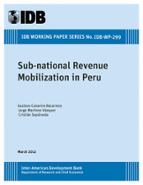Sub-national Revenue Mobilization in Peru
Date
Mar 2012
This paper analyzes the problem of sub-national revenue mobilization in Peru and proposes several policy reforms to improve collection performance while maintaining a sound revenue structure. In particular, the paper analyzes the current revenues of regional and municipal governments and identifies the main priorities for reform. Among the most important problems are the acute inequalities and inefficiencies associated with revenue sharing from extractive industries. These revenues represent a significant share of sub-national budgets and currently they are distributed without consideration of the relative expenditure needs or fiscal capacity of sub-national units. In order to address this problem, the paper proposes the incorporation of a measure of fiscal capacity into the formula of the FONCOMUN, the municipal equalization transfer program. Other reforms explored include the reassignment of revenue sources between municipal provincial and district governments and the assignment of new taxes to regional governments.




